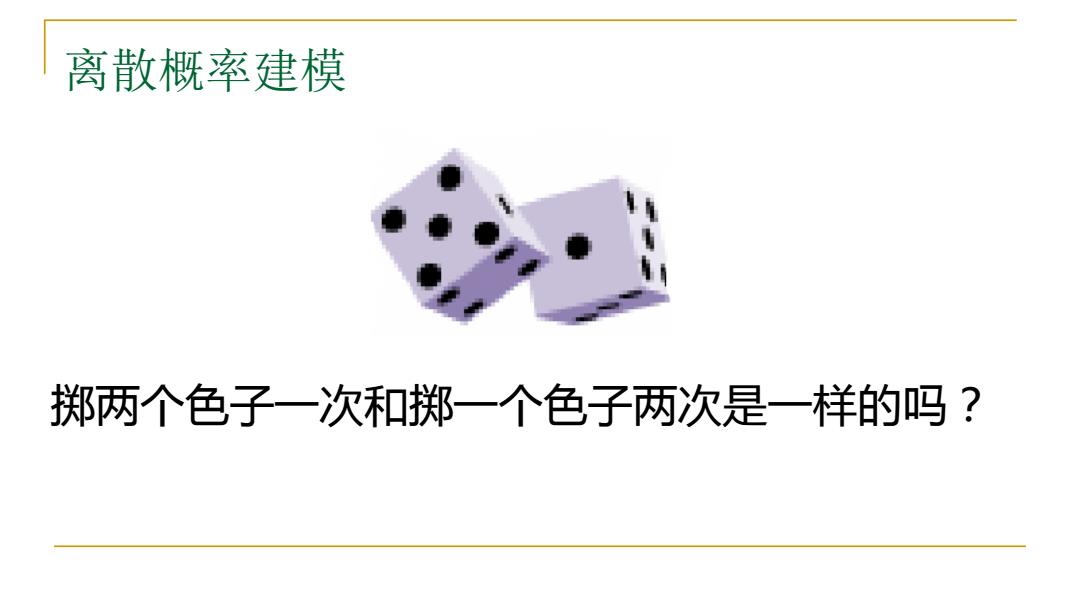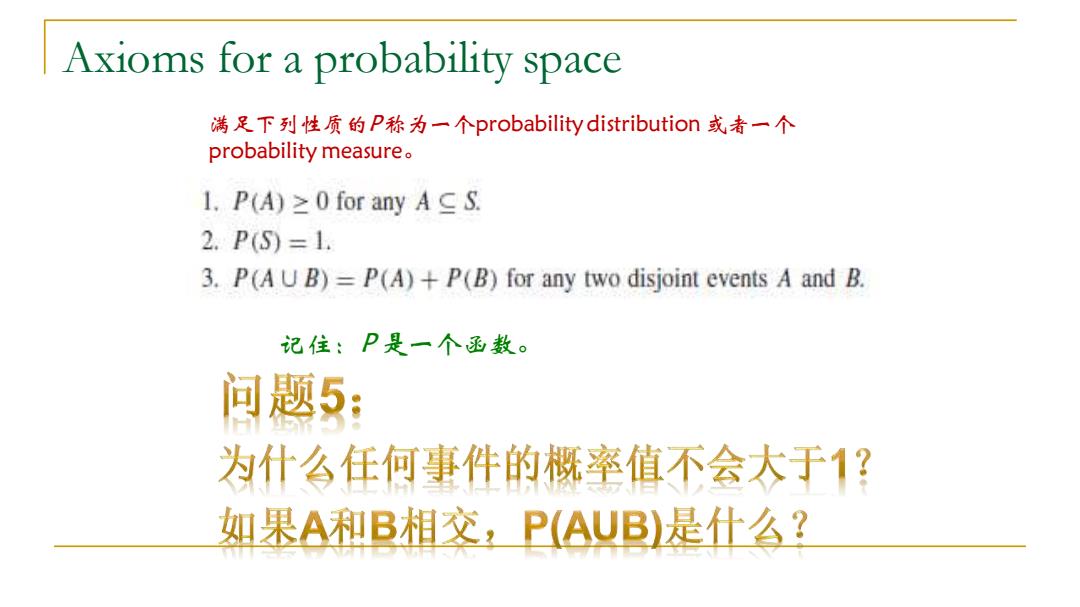
有限样本空间 There are only finite outcomes. Each outcomes individually consists an elementary event. For one coin toss,there are two outcomes-head and tail."Head"is an elementary event. The probability of an elementary event corresponds a specific outcome. If all outcomes are equally likely,then the probability of an event E can be computed as: p(E)=E total number of outcomes in E [A total number of outcomes
有限样本空间 ◼ There are only finite outcomes. ◼ Each outcomes individually consists an elementary event. ❑ For one coin toss, there are two outcomes – head and tail. “Head” is an elementary event. ◼ The probability of an elementary event corresponds a specific outcome. ◼ If all outcomes are equally likely, then the probability of an event E can be computed as: total number of outcomes total number of outcomes in | | | | ( ) E A E p E = =

离散概率建模 掷两个色子一次和掷一个色子两次是一样的吗?
离散概率建模 掷两个色子一次和掷一个色子两次是一样的吗?

Axioms for a probability space 满足下列性质的P称为一个probability distribution或者一个 probability measure. L.P(A)≥0 for any A C S. 2.P(S)=1 3.P(A U B)=P(A)+P(B)for any two disjoint events A and B. 记住:P是一个函数。 问题5: 为什台任何事件的概率值不会大于1? 如果A和B相交,P(AUB)是什么?
Axioms for a probability space 满足下列性质的P称为一个probability distribution 或者一个 probability measure。 记住:P 是一个函数

交集非空的事件 ■掷均匀的色子,掷3次。出现事件“或者3次均相等,或者没有一次是4” 的概率是多少? ■合理假设:每个outcome出现的可能性是一样的。 ■样本空间大小是63=216。 ·用F表示事件“3次结果一样”,则F=6(F={111,222,,666}》 ■用G表示事件“没有一次结果是4”,则1G=53=125(G是从集合{1,2,3,5,6} 中任选3个数的组合数) ■要求的事件为F和G的并集: IFUG=|F1+|G-lFnG=6+125-5=126 ■因此,最终结果是:126/216=7/12
交集非空的事件 ◼ 掷均匀的色子,掷3次。出现事件“或者3次均相等,或者没有一次是4” 的概率是多少? ◼ 合理假设:每个outcome出现的可能性是一样的。 ◼ 样本空间大小是 6 3=216。 ◼ 用F表示事件“3次结果一样”,则|F|=6 (F={111,222,…,666}) ◼ 用G表示事件“没有一次结果是4”,则|G|=53=125 (G是 从集合{1,2,3,5,6} 中任选3个数的组合数) ◼ 要求的事件为F和G的并集: |FG|=|F|+|G|-|FG|=6+125-5=126 ◼ 因此,最终结果是:126/216 = 7/12

包含排斥定律:否定形式 没有被包含在若干个子集的并集中的元素个数: N(AA,A)=N-S,+S2-S3+.+(-1)*Sk++(-1)Sn where,Sk=∑1A,nA,n.∩A|k=1,2,,n l≤i1≤i2≤≤ik≤n For an example:the formula for 4 subsets N-(IAH+A2H+A3H+A4) +(A1∩A2HlA1∩A2tlA1∩AtlA2∩A3t|A2∩AtlA3A4D -(A1∩A2∩A3+lA1OA2∩A4tlA1∩A3∩A4tlA2∩A3∩A4D +A1∩A2∩A3∩A4
包含-排斥定律: 否定形式 = = = − + − + + − + + − i i i n k i i i n n k k n k k S A A A k n N A A A N S S S S S 1 ... 1 2 1 2 3 1 2 1 2 where | ... | 1,2,..., ( ... ) ... ( 1) ... ( 1) , For an example:the formula for 4 subsets N - (|A1 |+ |A2 |+ |A3 |+ |A4 |) + (|A1A2 |+|A1A2 |+|A1A4 |+|A2A3 |+|A2A4 |+|A3A4 |) - (|A1A2A3 |+|A1A2A4 |+|A1A3A4 |+|A2A3A4 |) + |A1A2A3A4 | 没有被包含在若干个子集的并集中的元素个数: